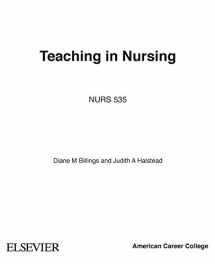
Teaching in Nursing: A Guide for Faculty, 4th Edition
Book details
Summary
Description
Teaching in Nursing, 4th Edition is the only nursing text to address all three components of education -- teaching, curriculum, and evaluation. Comprehensive guidelines help you meet the day-to-day challenges of teaching, including curriculum development, the diversity of student learning styles, and developing and using classroom tests. This edition has been updated with information on the latest trends in education including new information on the use of simulations to facilitate learning, the latest on competency-based and concept-focused curricula, developing learner-centered courses, and more. Edited by expert nursing educators Diane M. Billings and Judith A. Halstead, Teaching in Nursing is a past winner of the AJN Book of the Year award, and is an excellent resource for nurses preparing to take the Certified Nurse Educator (CNE) Exam.
- The only nursing resource to cover teaching, curriculum, and evaluation of students -- the three essential components of nursing education.
- Contributing authors are nationally recognized scholars in their fields of expertise.
- Models of teaching are used to demonstrate clinical teaching, teaching in interdisciplinary setting, how to evaluate students in the clinical setting, and how to adapt teaching for community-based practice.
- Teaching strategies promote critical thinking and active learning, including evaluation techniques, lesson planning, and constructing examinations.
- Evidence-based teaching boxes explain how to practice and apply evidence-based teaching, with implications for faculty development, administration, and the institution.
- End-of-chapter summaries let you draw conclusions based on the chapter content.
- Open-ended application questions at the end of each chapter are ideal for faculty-guided discussion and online education.
- Up-to-date research looks ahead to the needs of the future.
- Updated Clinical Simulations chapter describes the most up-to-date simulation products and includes new information on using simulations to facilitate learning.
- NEW! Expanded information on using technology to facilitate learning.
- An emphasis on curriculum includes information on the newest competency-based and concept-focused curricula.
- NEW Developing Learner-Centered Courses chapter presents new information on learner development and socialization.
- NEW Accreditation of Nursing Programs chapter provides an overview of how a program attains accreditation status, and explains the importance of having an accredited nursing program.
- A completely revised media chapter provides new information about classroom response systems, using digital media, and handheld devices in the classroom.
- The evaluation section has been expanded to be inclusive of program evaluation related to accreditation process.
- Expanded information on developing and using classroom tests includes specifics on writing effective multiple-choice questions and the importance of item discrimination.
- The latest distance learning information describes the positives and negatives of video conferencing, webinars, and the latest approaches to engaging learners at a distance.
- Coverage of online teaching includes examples of how to design a course using Web 2.0 tools.


We would LOVE it if you could help us and other readers by reviewing the book
Book review



